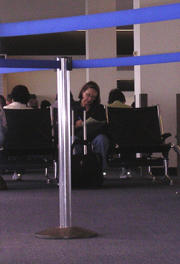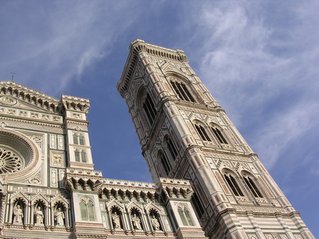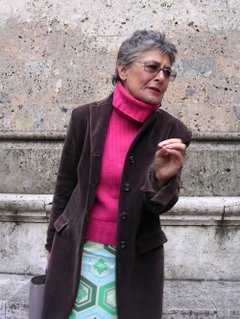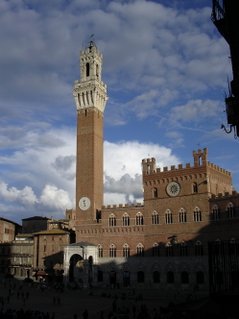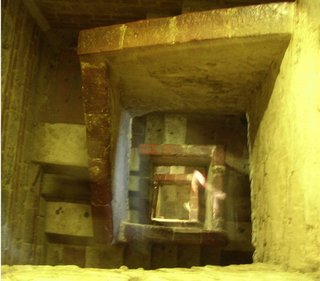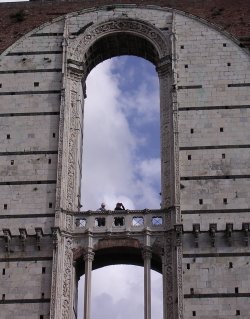picture gallery
After another sleepless night, my cough subsided enough for us to perform the long postponed rites for which Venice is named and famed. Euphoric to begin with, we walked out the door of the hotel and found a different city.
 The sunshine dazzled, the sky shone lapis blue, the buildings sparkled. We strolled down the shadowed “Calle” back toward the Rialto and found the gothic arched open-air fishmarket that had been an empty stone platform the previous afternoon packed with excited fishmongers and customers and with trays of squid, octopus, shrimp, and prawns. We made our way through the adjoining open air vegetable market and climbed the Rialto bridge and looked down the Grand Canal at a scene of unreal richness and beauty. This was what we came for–we and the millions of pilgrims who arrived here for the last thousand years: an ancient work of art that you can walk and ride around in.
The sunshine dazzled, the sky shone lapis blue, the buildings sparkled. We strolled down the shadowed “Calle” back toward the Rialto and found the gothic arched open-air fishmarket that had been an empty stone platform the previous afternoon packed with excited fishmongers and customers and with trays of squid, octopus, shrimp, and prawns. We made our way through the adjoining open air vegetable market and climbed the Rialto bridge and looked down the Grand Canal at a scene of unreal richness and beauty. This was what we came for–we and the millions of pilgrims who arrived here for the last thousand years: an ancient work of art that you can walk and ride around in.
We boarded Vaporetto 1 and found seats near the bow. Each second of the trip presented a new spectacular view: a gorgeous palace, a hanging garden, a luxurious gondola, the opening of a side canal down which one could see a world of bridges and towers, a church with a façade in classical, baroque or uniquely Venetian style. And within minutes, the whole overwhelming prospect transformed as the boat moved from one bank to the other and followed the waterway’s serpentine curves.
 Around one, the banks widened and the road ahead changed from a narrow river to a wide expanse of sea scattered with distant islands of towers and domes outlined against a vast sky. The right bank ended in a peninsula on which stood the cathedral of Salute–health. The left bank revealed the climbing tower of the familiar St. Mark’s Square, the anticipated climax of the voyage. I was grateful to be looking at much of this display through the tiny frame of the camera’s viewfinder, both to preserve the memory of it, and to contain my present impressions.
Around one, the banks widened and the road ahead changed from a narrow river to a wide expanse of sea scattered with distant islands of towers and domes outlined against a vast sky. The right bank ended in a peninsula on which stood the cathedral of Salute–health. The left bank revealed the climbing tower of the familiar St. Mark’s Square, the anticipated climax of the voyage. I was grateful to be looking at much of this display through the tiny frame of the camera’s viewfinder, both to preserve the memory of it, and to contain my present impressions.
The vaporetto emptied at the San Marco quay, and the wonderland sensation gave way to claustrophobia that reminded me of the crowding we had seen in the many frescoes of both heaven and hell. Jostelled along by a mob of fellow gawkers, past stand after stand of souvenir hawkers, I noticed a monstrous apparition growing on the horizon, blocking my view of the sea and the islands:
it was a cruise ship taller than any of the towers of Venice and as long as St. Marks plaza itself, heading straight for us, with mobs of tiny people crowding its decks–a barbaric invasion of the grossest modernity laying claim to this ancient sanctuary. I stood on line to use the public bathroom, and the dour woman at the turnstile told me the three day pass I flashed her would not work here and it would cost a euro to urinate. As we approached the famous square, along with endless lines of people waiting to enter tower, cathedral and palace, we saw the two huge facades under renovation covered with billboards advertising corporate sponsorship by Mazda and a hotel chain. My fatigue returned, so we wound our way back to the hotel through the shadowed labyrinth of tiny streets, tunnels and bridges between St. Marks and Rialto.
It was a relief to be back in our neighborhood, where the bright sunshine made every square meter of brickwork or pavement or façade or alley prospect into a visual and intellectual feast. After lunch in a quiet nearby square, our table at the edge of a tiny canal wharf, we penned a route that would end on the quay facing the island of Iudecca through the maze on our map. The souk-like layout of the city makes this a challenge, since almost no streets are longer than 100 yards, and many are dead ended at cul-de-sacs, wharves, and gates. Each of the twists and turns presents new delights–fountains, entryways, rooftop gardens and clotheslines, contrasts of texture, color, form that have evolved and ripened over the ages, walls and tunnels darkly framing the sundrenched images ahead.
Every few minutes, the slot canyons of streets and canals open to a small piazza–a space by a church or civic building graced with cafes and occasionally a few trees. A third of the way through our itinerary, we stopped at one and I sat in the sun on the steps of a little bridge and nodded off into a luscious slumber. Jan awakened me after a few minutes and urged we go back to the hotel, where I tried to continue my nap as she started trying to locate a doctor. The Blue Cross contact phone numbers she had brought yielded only discussions with people in India and no medical referral, while I regained strength, encouraged by an ability to sleep without coughing. We went out again, for a short sortie, and found ourselves at a flea market in the piazza of San Silvestre. This was a strictly local event, where kids played and residents sold stuff they collected. Jan needed a hat to replace the crummy one she had purchased from a stall in San Marco. On one of the tables we found a finely crafted Tyrolean chapeau and managed in pidgin Italian to bargain the seller to an acceptable price. The first full night sleep in over a week came early.
Saturday morning is again brilliant weather. We decide to spend two more nights in Venice and abandon the idea of going to Padua or Verona before meeting our Elderhostel group in Siena. There’s no room at the Mercanti but after a short search we find another place nearby, The Vecie Poste: the room a little less money, a lot less plush, bordering a small canal and graced with the occasional fragrance of sewage. In contrast to the robotic filipino gentlemen who ran the Mercanti, this place has a manager who’s a real concierge–the brother of the owner of a fine restaurant with the same name next door.
Roaming the immediate neighborhood we find an internet access place, located at the back of a blue jeans store, reached through a pigeon-shit caked alley strongly smelling of sewage to catch up on email. I tire and we return to our room with picnic lunch for a rest. Jan has found announcement of free concert at 4:00 in the Church of Salute. We leave early and now expertly find San Silvestre Vaporetto stop. We sit on the steps of this cathedral, looking out at the islands in the lagoon and San Marco in the afternoon sun and then walk around it through back streets which reveal some of the infrastructure repairs that appear all over the city. Part of a small canal has been sealed off to replace ancient leaking lead sew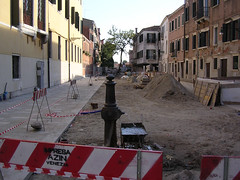 er pipes and stone and wood foundations of houses and to raise the pathway a foot to protect it from flood tides and provide space underneath for the electrical lines and other infrastructure that are now attached to the outside of buildings. The old stones of the original walkway are stored in piles to be put back in place and create the illusion of antiquity. This reminds me of the restoration of Walden Pond I saw a couple of years ago in Massachusetts. Human impacts had created so much erosion that the banks were all bulldozed and new rock and sand and vegetation were installed and stabilized with heavy steel netting that was only visible if pointed out. Restoration like this is observable everywhere in the city. The effort, skill and cost required must be astronomical, and as it proceeds, the old decaying Venice will indeed turn into a new theme-park version.
er pipes and stone and wood foundations of houses and to raise the pathway a foot to protect it from flood tides and provide space underneath for the electrical lines and other infrastructure that are now attached to the outside of buildings. The old stones of the original walkway are stored in piles to be put back in place and create the illusion of antiquity. This reminds me of the restoration of Walden Pond I saw a couple of years ago in Massachusetts. Human impacts had created so much erosion that the banks were all bulldozed and new rock and sand and vegetation were installed and stabilized with heavy steel netting that was only visible if pointed out. Restoration like this is observable everywhere in the city. The effort, skill and cost required must be astronomical, and as it proceeds, the old decaying Venice will indeed turn into a new theme-park version.
We returned to Salute in time to get good seats for the concert of Bach solo cello suites played by a passionate young artist sitting by himself in a chair in front of the altar. For the last section of the program–a concerto duet with organ–he disappeared into the loft and then appeared again up high to take bows with the young woman accompanying him.  The cavernous cathedral made the music reverberate, but watching the performers hands and facial expressions helped to articulate the sound. The longer I sat the more I could appreciate the wealth of detail in the baroque interior, the hanging lamps of varied and coordinated design, the huge torsioned sculptures of the four evangelists leaning on the high pediments, the dozens of additional figures nestled in alcoves, and the light coming through the windows reflected off the water outside getting more brilliant as the afternoon deepened. The full baroque experience converged on the sculptural complex atop the high altar: a triumphant woman holding an infant in her arms, an old man to the right kneeling at her feet with arms outstretched in gratitude and to the left an ugly figure in flight covering his face. The guidebook explanation hit home–this church was a tribute to the Virgin Mary erected by the Venetians in gratitude for the cessation of the plague in the late seventeenth century. Its name, Salute, means health.
The cavernous cathedral made the music reverberate, but watching the performers hands and facial expressions helped to articulate the sound. The longer I sat the more I could appreciate the wealth of detail in the baroque interior, the hanging lamps of varied and coordinated design, the huge torsioned sculptures of the four evangelists leaning on the high pediments, the dozens of additional figures nestled in alcoves, and the light coming through the windows reflected off the water outside getting more brilliant as the afternoon deepened. The full baroque experience converged on the sculptural complex atop the high altar: a triumphant woman holding an infant in her arms, an old man to the right kneeling at her feet with arms outstretched in gratitude and to the left an ugly figure in flight covering his face. The guidebook explanation hit home–this church was a tribute to the Virgin Mary erected by the Venetians in gratitude for the cessation of the plague in the late seventeenth century. Its name, Salute, means health.
 After the concert we took a walk along the great promenade facing the island of Giudecca across the lagoon. The wide walkway and the broad expanse of water was a welcome contrast to the exquisite but confining vistas of the calles and rivos where we’d spent the earlier part of the day and most of yesterday. Before taking the Vaporetto back home, we had a drink in a café on pilings over the water. The setting sun painted Jan gold in her new Venetian hat.
After the concert we took a walk along the great promenade facing the island of Giudecca across the lagoon. The wide walkway and the broad expanse of water was a welcome contrast to the exquisite but confining vistas of the calles and rivos where we’d spent the earlier part of the day and most of yesterday. Before taking the Vaporetto back home, we had a drink in a café on pilings over the water. The setting sun painted Jan gold in her new Venetian hat.

